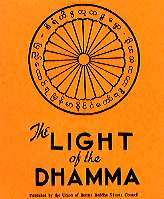
Golden Drizzle of Burmese New Year
Khin Mar On

Vol. III, No. 1, 1983
|
|
Golden Drizzle of Burmese New Year Khin Mar On |

Vol. III, No. 1, 1983 |
The weather has been hot and dry since the beginning of March. The harvest has been gathered and a joyous sound of a Burmese drum (byaw) 'toke, toke, byone' can be heard. At this time of the year Burmese usually celebrate the Ordination (Shinpyu ceremonies; nevertheless, farmers, like his follow workers, find the weather monotonous. But when the North Wind carries sweet smell of the earth, there is an excitement for the Burmese New Year is approaching. The feat of New Year is known to the Buddhists as the Thingyan (Water Festival). It falls usually during the period, 13th to 16th April or 14th to 16th April in the Western Calendar. Thingyan is termed in Burmese astrology as the feast of the Great Thagyamin (King of gods). Burmese Nationals believed that at this time of New Year King Thagyamin used to visit the human abode to survey the moral condition of people of the world. Hence, adults warn and admonish their children to be in good behaviour not to use harsh language and lies; the adults too, avoid all evil things; fast and observe eight or ten Precepts and pay homage to the Monasteries and Pagodas. They also attend the Dhamma lectures of the Venerable Theras. The word Thingyan is derived from a Sanskrit word (sankranta) meaning, the entry of the Sun to any of the twelve regions in the zodiac; it marks the movement of the sun from the region of Pisces or Fishes to the region of Aries or the Ram. It therefore marks the end of one solar year and the beginning of another. Thereupon the Water feast is the period covered by the sun when it moves out of Pisces and is passing through a sort of no man's land between the two regions. Tagu (April) is an entrance to the summer. At this time of the year ponds and streams show signs to dry up; the soil get scorched, making holes here and there in the pound. In the middle of April just before or sometimes after the water feast, droplets of rain visit the thirsty ground. After these light showers, the skeleton stems of the trees are dressed up again with new sprouts. Hence, Tagu signifies the month when new leaves are pluck. During the three days (or some times four days) of the water feast, the youngsters show merriment by throwing water; gaily dressed, drive round the town in motorcars, throwing water and getting drenched in return. Early in the morning, young men and women including the children gather on the roadsides with pails and buckets of water ready to throw water onto any passersby. There are also merry-makers who decorated themselves in dresses shouting slogans and singing songs. A new year is a time for a joyous occasion. Housewives prepare cold drinks and sweet cakes which are sent as presents to the neighbours. These are gifts of charity to all people. The typical food donation in this Thingyan period is the famous "Mont-lone-yebaw", the floating rice-balls. "Mont-lone-yebaw" is the most suitable food donation, because each and every person, old and young, participate in making the food. The glutinous rice, mixed with a certain amount of rough rice, is grilled in water which is left for a night. A large pot of boiling water is prepared in the next morning, ladies make small balls of this glutinous rice paste with a piece of jaggary inserted in every ball. These balls, put into boiling water for a few minutes, came above the surface like floating buoys, cooked and ready to serve. A handful of these balls were then served on plates sprinkled with sliced coconut. The first three plates arc offered to the Buddha, the Dhamma and the Sangha. The rest are sent as presents to the neighbourhood. All the passersby are also served. It is a great fun to see this party of ''Mont—lone—yebaw" with young men singing and dancing around the ladies preparing the food. Every now and then splashes of water come upon one another enjoying the water feast. Every person nearby could not help amused and delighted by seeing this joyous scene. After the days of boisterous water throwing and merry-making, peace prevail on the New Year day. This day is celebrated in a noble sense. Young female members of the locality give respect to the aged by attending to the manicure and shampooing while the males clean the Buddha images with water at home and at pagodas, the precincts of Pagodas are swept and cleaned as well. All Buddhists throughout the land rededicate themselves to follow the peaceful path of the Buddha by showing respect to the aged people. This is taught in the Manga1a Sutta which is broadcast over the radio in the morning of the New Year Day by some Venerable Theras. In the afternoon, the ceremony of freeing fishes are performed. In the evening Metta paritta is recited in every quarter of the town so that peace and happiness may prevail in the whole world. These enjoyable events of the Buddhist will last forever under the sacred flags of the Buddha Sasana. Hence Thingyan is rewarded, with a yellow tinge of the seasonal flowers - Gardenia (Yingat), Cassia fistula (Ngu) and the famous Pterocarpus (Padauk). These flowers, bright golden and yellow, symbolize the new year festival. |